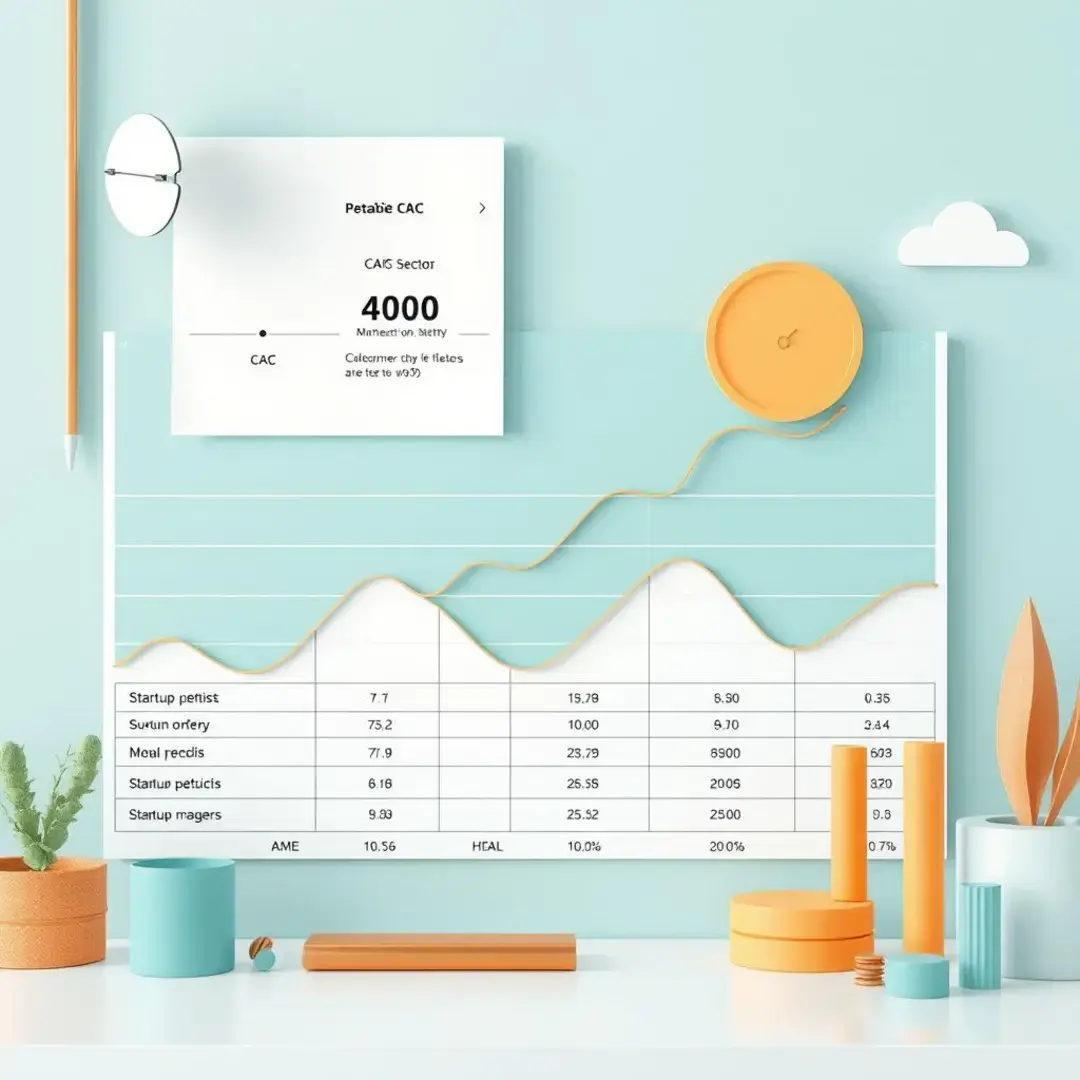How to Calculate CAC in Different Sectors
Understanding CAC and its Importance

Defining Customer Acquisition Cost (CAC)
Customer Acquisition Cost (CAC) is a key performance indicator that measures the cost associated with acquiring a new customer. It encompasses all the expenses involved in engaging potential customers and converting them into paying clients. Calculating CAC is crucial for businesses, as it directly influences marketing strategies and budget allocations across different sectors.
Understanding CAC allows companies to fine-tune their marketing strategies and ensure more effective allocation of resources. When a business knows its CAC, it can better judge the viability of its marketing campaigns, improving ROI over time. Additionally, tracking this metric helps startups be competitive in crowded markets by ensuring they spend wisely when pursuing new customers.
The relationship between CAC and Customer Lifetime Value (CLTV) is fundamental in determining the overall health of a business. While CAC indicates how much a company spends to acquire a customer, CLTV tells how much revenue that customer can generate over their entire relationship with the company. Ideally, businesses should aim for a CAC to CLTV ratio of 1:3, meaning that for every dollar spent acquiring a customer, they should aim to earn three dollars back.
Key Factors Influencing CAC
A significant factor that influences CAC is marketing spend; the more money a business allocates to marketing, the higher the initial output and reach. However, businesses must balance this with effectiveness; high spending without measurable results can inflate CAC unnecessarily. Thus, localizing and segmenting marketing campaigns is vital to ensuring that the target audience receives messages that resonate.
The length of the sales cycle can have a direct correlation with CAC. For example, shorter sales cycles typically lead to lower CAC, while longer cycles require more extensive marketing and sales efforts, increasing costs. Businesses must strategize effectively based on their sales cycles, implementing techniques that shorten the process without compromising the quality of leads.
Understanding your target audience is instrumental in calculating CAC accurately. Different demographics and behaviors can lead to varying acquisition costs, meaning that a one-size-fits-all approach may not be effective. Tailoring marketing strategies to specific audience segments can result in lower CAC and higher conversion rates.
Calculating CAC in Specific Sectors

SaaS (Software as a Service)
In the SaaS sector, CAC calculations often integrate various components, primarily focusing on the subscription model. By totaling all sales and marketing expenses over a specific period and dividing that by the number of new customers acquired during the same time frame, businesses can derive a more accurate CAC. This model becomes increasingly complex when considering tiered subscription levels and upselling strategies.
Another critical factor in the SaaS sector is the churn rate, or the percentage of customers who discontinue using the service. High churn rates can lead to an inflated CAC, as companies are continually spending to replace lost customers. Evaluating CAC alongside CLTV provides better insights into profitability and sustainable growth, ensuring the acquisition strategy aligns with customer retention efforts.
To enhance CAC calculations, SaaS companies can implement advanced metrics such as Payback Period (the time it takes to recover CAC) and Net CAC (considering revenue lost from churn). This deeper analysis helps businesses understand not just how much they spend on acquiring customers, but also how efficiently they can recoup those costs.
E-commerce
For e-commerce businesses, CAC calculation often focuses on the effectiveness of various digital marketing channels. By monitoring ad spend across platforms like Google Ads and Facebook, along with analysis of sales converted from those leads, businesses can pinpoint their ideal CAC. This requires a strategic focus on not only spending but also optimizing the customer journey to reduce bounce rates and enhance conversions.
Digital marketing channels significantly influence CAC in e-commerce. Each channel, whether SEO, paid advertising, or social media, carries different costs and conversion rates. Thus, e-commerce businesses must continually test and analyze their channel performance to optimize spending effectively.
Implementing attribution modeling is essential for e-commerce businesses that want to attain an accurate CAC calculation. This sophisticated method helps determine which marketing activities lead to conversions, allowing businesses to allocate their budgets more effectively. Without proper attribution, companies risk pouring money into ineffective channels while neglecting those that drive actual sales.
B2B (Business-to-Business)
B2B businesses often face longer sales cycles than their B2C counterparts, complicating CAC calculations. These longer cycles necessitate a cumulative approach to marketing costs, as expenses may span several months or even years before seeing a return on investment. Businesses should assess CAC over different stages of the sales cycle to ensure they capture the full scope of their acquisition costs.
Effective lead generation and qualification processes significantly influence B2B CAC. By focusing on generating high-quality leads, companies can reduce the amount spent on conversions, achieving a lower CAC. Additionally, well-structured sales funnels help streamline the qualification process, ensuring marketing resources are directed toward leads that are more likely to close.
Customizing CAC analysis to evaluate specific marketing campaigns and the performance of sales teams provides valuable insights for B2B enterprises. By breaking down CAC based on various campaigns, companies can identify which strategies yield the best ROI. This granular approach allows businesses to coach their marketing and sales teams toward improving their methods and achieving better performance.
Optimizing CAC Across Sectors

Strategies for Reducing CAC
One of the most effective strategies to reduce CAC is by improving conversion rates through targeted marketing efforts. By leveraging customer data and segmentation, businesses can better understand their audiences and tailor campaigns that resonate with them, thus increasing the likelihood of converting prospects into customers. This not only enhances overall sales performance but also reduces the cost incurred per acquisition.
Automating marketing processes plays a vital role in enhancing efficiency, which can lead to lower CAC. By utilizing tools and software for email campaigns, social media management, and customer relationship management, businesses can minimize manual work and ensure consistency across their marketing efforts. automation allows for a streamlined approach to nurturing leads while freeing up valuable time for team members to focus on strategy and execution.
Leveraging customer referrals and advocacy is another powerful method to reduce CAC. When existing customers recommend a product or service, it not only builds trust with potential customers but also lowers acquisition costs significantly. Implementing referral programs incentivizes satisfied customers to spread the word, creating a win-win situation for both the business and its loyal clientele.
Advanced CAC Analysis and Reporting
Conducting cohort analysis is crucial for businesses aiming to understand CAC trends over time. By grouping customers based on similar characteristics or behavior, companies can analyze how different cohorts respond to acquisition strategies. This insight allows for highly targeted adjustments, optimizing marketing efforts for different customer segments.
Predictive modeling can provide businesses with projections of future CAC based on current data and trends. By analyzing historical data and applying statistical methods, organizations can foresee how changes in marketing strategies may affect their CAC. This foresight enables proactive decision-making, allowing businesses to adjust their acquisition strategies in anticipation of market shifts.
Finally, integrating CAC data with other key business metrics provides a comprehensive understanding of a company’s performance. Analyzing CAC alongside metrics like CLTV and conversion rates allows for an informed view of profitability and growth potential. This holistic approach can guide strategic decisions, ensuring that startup-challenges-and-solutions/customer-acquisition/” rel=”noopener”>customer acquisition efforts align with broader business objectives.
Benchmarking and Industry Best Practices

Comparing CAC across different sectors
Benchmarking CAC allows businesses to cross-compare their acquisition costs with industry standards. By understanding how their CAC stacks up against competitors, organizations can identify areas for improvement and implement strategies to enhance efficiency. This comparison also assists startups in setting realistic targets and refining their customer acquisition strategies to align with market expectations.
Analyzing CAC benchmarks across specific industries can provide vital insight into where a business stands in its acquisition efforts. Different sectors have different average CAC values, influenced by factors such as competition, marketing effectiveness, and customer behavior. By studying these benchmarks, businesses can adopt best practices and enhance their own strategies to achieve superior outcomes in customer acquisition.
Utilizing CAC data for competitive analysis allows businesses to gauge their positioning in the market. By understanding how competition is performing in terms of acquisition costs, companies can adjust their strategies to align or differentiate themselves appropriately. This data is invaluable for resource allocation, informing marketing tactics, and fostering innovation to stay ahead in the race for customers.













